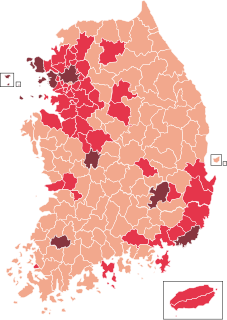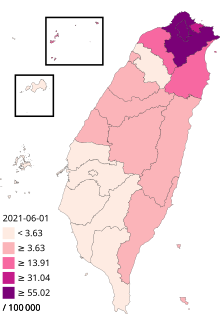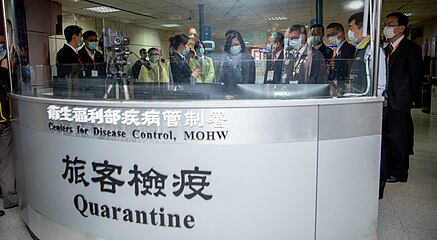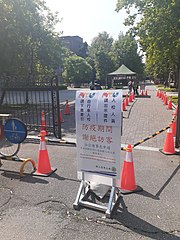The following lists events that happened during 2020 in China.
The Huanan Seafood Wholesale Market, also known as the Huanan Seafood Market, was a live animal and seafood market in Jianghan District, Wuhan, Hubei, China. The market gained media attention after being identified as a possible point of origin of the 2019–20 coronavirus pandemic. The World Health Organization was notified on 31 December 2019 about an outbreak of pneumonia in Wuhan. Of the initial 41 people hospitalized with pneumonia who were officially identified as having laboratory-confirmed SARS-CoV-2 infection by 2 January 2020, two-thirds were exposed to the market. The market was closed on 1 January 2020 for sanitary procedures and disinfection. Thirty-three out of 585 environmental samples obtained from the market indicated evidence of coronavirus disease 2019 (COVID-19), according to the Chinese Center for Disease Control and Prevention.

This article lists evacuations conducted as a result of the pandemic of coronavirus disease 2019 (COVID-19).

The 2019–20 coronavirus pandemic has had far-reaching consequences beyond the spread of the COVID-19 disease itself and efforts to quarantine it. As the SARS-CoV-2 virus has spread around the globe, concerns have shifted from supply-side manufacturing issues to decreased business in the services sector. The pandemic caused the largest global recession in history, with more than a third of the global population at the time being placed on lockdown.

Coronavirus disease 2019 (COVID-19) is an infectious disease caused by severe acute respiratory syndrome coronavirus 2 (SARS-CoV-2). The disease was first identified in December 2019 in Wuhan, the capital of China's Hubei province, and has since spread globally, resulting in the ongoing 2019–20 coronavirus pandemic. As of 3 May 2020, more than 3.5 million cases have been reported across 187 countries and territories, resulting in more than 247,000 deaths. More than 1.12 million people have recovered.

The 2019–20 coronavirus pandemic of COVID-19 has resulted in conspiracy theories and misinformation regarding its origin, scale, and the prevention, diagnosis, and treatment of the disease. False information, including intentional disinformation, has been spread through social media, text messages, and mass media, including the state media of countries such as China, Russia, Iran, and Turkmenistan. It has been propagated by celebrities, politicians, and other prominent public figures. Commercial scams have claimed to offer at-home tests, supposed preventives, and "miracle" cures. Other actors have claimed the virus is a bio-weapon with a patented vaccine, a population control scheme, or the result of a spy operation. The World Health Organization has declared an "infodemic" of incorrect information about the virus, which poses risks to global health.

The presence of coronavirus disease 2019 (COVID-19) in Malaysia, part of the 2019–20 coronavirus pandemic, was first reported in January 2020 when it was detected on travellers from China arriving via Singapore on 25 January, following the outbreak of COVID-19 in Hubei, China. Reported cases remained relatively low and were largely confined to imported cases, until localised clusters began to emerge in March; the largest cluster was linked to a Tablighi Jamaat religious gathering held in Sri Petaling, Kuala Lumpur in late February and early March, leading to massive spikes in local cases and an exportation of cases to neighbouring countries. Within a few weeks, Malaysia had recorded the largest cumulative number of confirmed COVID-19 infections in Southeast Asia, breaching over the 2,000 mark in active cases by the end of March from fewer than 30 at the start of the month. By 16 March, the virus is reported in every state and federal territory in the country.

The ongoing pandemic of coronavirus disease 2019, a novel infectious disease caused by severe acute respiratory syndrome coronavirus 2, spread to South Korea on 20 January 2020, when the first case was announced. The number of confirmed cases increased on 19 February by 20, and on 20 February by 58 or 70, giving a total of 346 confirmed cases on 21 February 2020, according to the Centers for Disease Control and Prevention Korea (KCDC), with the sudden jump mostly attributed to "Patient 31" who participated in a gathering at a Shincheonji Church of Jesus the Temple of the Tabernacle of the Testimony church in Daegu.

The ongoing pandemic of coronavirus disease 2019, a novel infectious disease caused by severe acute respiratory syndrome coronavirus 2, soon spread to Hong Kong, and the first confirmed case was announced on 23 January 2020. Confirmed cases are generally transferred to Princess Margaret Hospital's Infectious Disease Centre for isolation and centralised treatment. On 5 February, only after a 4-day strike by front line medical workers did the Hong Kong government close all but three border control points – Hong Kong International Airport, Shenzhen Bay Control Point, and Hong Kong-Zhuhai-Macao Bridge Control Point remaining open. As of 25 April 2020, Hong Kong had 1,036 confirmed cases, 753 recovered cases and four death cases.

The 2019–20 coronavirus pandemic was confirmed to have reached North America in January 2020. As of 25 March 2020, all North American countries have reported at least one case of COVID-19.

National responses to the 2019–20 coronavirus pandemic have been varied, and have included containment measures such as lockdowns, quarantines, and curfews. As of late April, there are 2.9 million cases of COVID-19 and over 203,800 deaths in 210 countries and territories around the world. The most affected countries in terms of confirmed cases being the United States, Spain, Italy, France, Germany, the United Kingdom, Turkey and China.

There are no officially confirmed cases of COVID-19 in North Korea, though foreign analysts believe that the virus has spread to the country. The North Korean government has taken extensive measures, including quarantines and travel restrictions, which US analyst website 38 North said appeared to be successful in containing the virus.
The Special Act on COVID-19 Prevention, Relief and Restoration, also known as the Special Act on COVID-19 Prevention, Relief and Recovery, is a law of the Republic of China regulating response and relief efforts related to the 2020 coronavirus pandemic in Taiwan.

The World Health Organization is a leading organization involved in the global coordination for mitigating the 2019-20 coronavirus pandemic. On 5 January 2020, the WHO notified the world about "pneumonia of unknown cause" from China and subsequently followed up with investigating the disease. On 20 January, the WHO confirmed human-to-human transmission of the disease. On 30 January, the WHO declared the outbreak a Public Health Emergency of International Concern and warned all countries to prepare. On 11 March, WHO said that the outbreak constituted a pandemic. The WHO has spearheaded several initiatives like COVID-19 Solidarity Response Fund for fundraising for the pandemic and Solidarity Trial for investigating potential treatment options for the disease. The WHO has been criticized by various observers as reacting too slowly, or of being unable to criticize China.
Ih-Jen Su is a Taiwanese medical researcher and distinguished investigator and director of the Division of Infectious Diseases at the National Health Research Institutes in Taipei, Taiwan. He is the expert responsible for suppressing the COVID-19 coronavirus in Taiwan.
The Central Epidemic Command Center is an agency of the National Health Command Center (NHCC). It has been activated by the government of Taiwan for several disease outbreaks, as the 2009 swine flu pandemic and the 2019–20 coronavirus pandemic. The head of the agency is Chen Shih-chung, the minister of Health and Welfare. The CECC is associated with the Taiwan Centers for Disease Control.

This article documents the chronology and epidemiology of the severe acute respiratory syndrome coronavirus 2 (SARS-CoV-2), the virus responsible for the 2019–20 coronavirus pandemic, which was first detected in Wuhan, China. Some developments may become known or fully understood only in retrospect.

This article documents the chronology of the response to the 2019–20 coronavirus pandemic in February 2020, which originated in Wuhan, China in December 2019. Some developments may become known or fully understood only in retrospect. Reporting on this outbreak began in December 2019.







![With population of 23.8 million, Taiwan has been producing more than 10 million masks per day since March. 02.05 Zong Tong Fang Shi [Tai Wan Kang Jiang Zhi Zao Gong Si ] (49491845167).jpg](http://upload.wikimedia.org/wikipedia/commons/thumb/2/24/02.05_%E7%B8%BD%E7%B5%B1%E8%A8%AA%E8%A6%96%E3%80%8C%E5%8F%B0%E7%81%A3%E5%BA%B7%E5%8C%A0%E8%A3%BD%E9%80%A0%E5%85%AC%E5%8F%B8%E3%80%8D_%2849491845167%29.jpg/440px-02.05_%E7%B8%BD%E7%B5%B1%E8%A8%AA%E8%A6%96%E3%80%8C%E5%8F%B0%E7%81%A3%E5%BA%B7%E5%8C%A0%E8%A3%BD%E9%80%A0%E5%85%AC%E5%8F%B8%E3%80%8D_%2849491845167%29.jpg)

![President Tsai Ing-wen wearing a mask 04.02 Zong Tong Shi Cha [Zhong Yang Liu Xing Yi Qing Zhi Hui Zhong Xin ] 49726568957 66543b616e o.jpg](http://upload.wikimedia.org/wikipedia/commons/thumb/3/38/04.02_%E7%B8%BD%E7%B5%B1%E8%A6%96%E5%AF%9F%E3%80%8C%E4%B8%AD%E5%A4%AE%E6%B5%81%E8%A1%8C%E7%96%AB%E6%83%85%E6%8C%87%E6%8F%AE%E4%B8%AD%E5%BF%83%E3%80%8D_49726568957_66543b616e_o.jpg/440px-04.02_%E7%B8%BD%E7%B5%B1%E8%A6%96%E5%AF%9F%E3%80%8C%E4%B8%AD%E5%A4%AE%E6%B5%81%E8%A1%8C%E7%96%AB%E6%83%85%E6%8C%87%E6%8F%AE%E4%B8%AD%E5%BF%83%E3%80%8D_49726568957_66543b616e_o.jpg)









